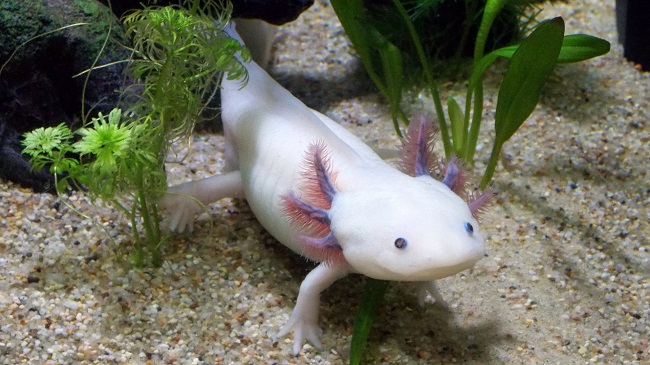Axolotls, also known as Mexican Walking Fish, are renowned for their striking variety of color morphs, each contributing to the allure of these fascinating creatures.
These amphibians, which retain their larval features throughout their life, come in an impressive array of colors, ranging from wild types with dark hues to leucistic axolotls with their brilliant white tones.
This article dives into the 13 types of axolotl colors and morphs, along with the genetic reasons behind these captivating variations.

The 13 Types of Axolotl Colors & Morphs
Here is a list of 13 Types of Axolotl Colors & Morphs
Read Also:
1. Wild Type
The wild type axolotl is characterized by a dark hue, usually a combination of greens, blacks, and browns. Their coloration serves as an effective camouflage in their natural habitats.
2. Leucistic
Leucistic axolotls are pure white or pink with striking black or dark blue eyes. Unlike albinos, they can produce melanin, but it’s generally absent from their skin.
3. Golden Albino
Golden albino axolotls showcase a lovely range of gold, peach, and pink hues. They have clear or red eyes due to the lack of melanin and the visibility of blood vessels.
4. White Albino
White albinos, as their name suggests, are completely white and have clear or red eyes. This color morph is quite rare and sought after in the pet trade.
5. Melanoid
Melanoid axolotls exhibit solid black or very dark brown color. Unlike wild types, they lack iridophores and xanthophores, which gives them their uniform coloration.
6. Copper
The copper axolotl is a relatively new color morph, showcasing a beautiful range of burnt orange and copper tones. Their eyes are generally light-colored.
7. Silver Dalmatian
Silver Dalmatians exhibit a pale or light silver color with darker freckles or spots throughout their bodies, giving them the name.
8. GFP (Green Fluorescent Protein)
GFP axolotls have been genetically modified to produce a protein that makes them glow green under UV light. They can be any color morph but are commonly found in leucistics.
9. Mosaic
Mosaic axolotls are the result of two fertilized cells merging, producing an axolotl with two different types of cell, which often leads to a mix of two color morphs.
10. Chimera
Similar to mosaics, chimeras result from the fusion of two embryos, leading to an axolotl with two different color morphs, usually split down the middle.
11. Enigma
Enigma axolotls are characterized by their irregular and random patches of pigmentation, making each individual unique.
12. Piebald
Piebald axolotls exhibit patches of unpigmented white or pink skin mixed with a base color, similar to a dappled horse.
13. Lavender
Lavender axolotls, a newer morph, showcase a delicate mix of purples, pinks, and greys, giving them a ‘lavender’ appearance.
The Science Behind Axolotl Color Variations
The diversity in axolotl colors and morphs results from the interaction of various genes that control pigmentation. Three primary layers of pigment cells, known as chromatophores, determine the axolotl’s final color.
These include melanophores (black/brown pigments), xanthophores (yellow/red pigments), and iridophores (reflective/glowing pigments). The presence, absence, or modification of these chromatophores due to genetic factors results in the different axolotl color morphs.
Read Also:
Conclusion
From the natural hues of the wild type to the unique glow of the GFP axolotl, the diverse color palette of axolotl morphs is truly captivating.
Each axolotl color morph brings a different aesthetic appeal, adding to the intrigue and charm of these amazing creatures.
By understanding the genetics behind these color variations, we can appreciate these splendid creatures even more.
Whether you’re an axolotl enthusiast or considering one as a pet, we hope this comprehensive guide to axolotl colors and morphs enhances your admiration for these remarkable creatures and aids in making informed choices.
























